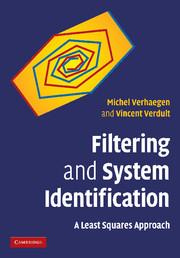Book contents
- Frontmatter
- Contents
- Preface
- Notation and symbols
- List of abbreviations
- 1 Introduction
- 2 Linear algebra
- 3 Discrete-time signals and systems
- 4 Random variables and signals
- 5 Kalman filtering
- 6 Estimation of spectra and frequency-response functions
- 7 Output-error parametric model estimation
- 8 Prediction-error parametric model estimation
- 9 Subspace model identification
- 10 The system-identification cycle
- References
- Index
2 - Linear algebra
Published online by Cambridge University Press: 14 January 2010
- Frontmatter
- Contents
- Preface
- Notation and symbols
- List of abbreviations
- 1 Introduction
- 2 Linear algebra
- 3 Discrete-time signals and systems
- 4 Random variables and signals
- 5 Kalman filtering
- 6 Estimation of spectra and frequency-response functions
- 7 Output-error parametric model estimation
- 8 Prediction-error parametric model estimation
- 9 Subspace model identification
- 10 The system-identification cycle
- References
- Index
Summary
After studying this chapter you will be able to
apply basic operations to vectors and matrices;
define a vector space;
define a subspace of a vector space;
compute the rank of a matrix;
list the four fundamental subspaces defined by a linear transformation;
compute the inverse, determinant, eigenvalues, and eigenvectors of a square matrix.
describe what positive-definite matrices are;
compute some important matrix decompositions, such as the eigenvalue decomposition, the singular-value decomposition and the QR factorization;
solve linear equations using techniques from linear algebra;
describe the deterministic least-squares problem; and
solve the deterministic least-squares problem in numerically sound ways.
Introduction
In this chapter we review some basic topics from linear algebra. The material presented is frequently used in the subsequent chapters.
Since the 1960s linear algebra has gained a prominent role in engineering as a contributing factor to the success of technological breakthroughs.
Linear algebra provides tools for numerically solving system-theoretic problems, such as filtering and control problems. The widespread use of linear algebra tools in engineering has in its turn stimulated the development of the field of linear algebra, especially the numerical analysis of algorithms. A boost to the prominent role of linear algebra in engineering has certainly been provided by the introduction and widespread use of computer-aided-design packages such as Matlab (MathWorks, 2000b) and SciLab (Gomez, 1999). The user-friendliness of these packages allow us to program solutions for complex system-theoretic problems in just a few lines of code.
- Type
- Chapter
- Information
- Filtering and System IdentificationA Least Squares Approach, pp. 8 - 41Publisher: Cambridge University PressPrint publication year: 2007



